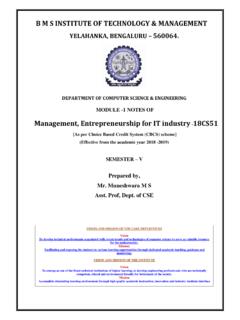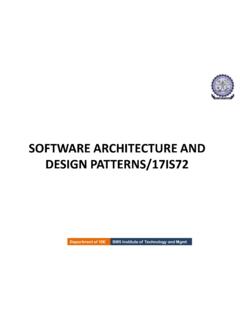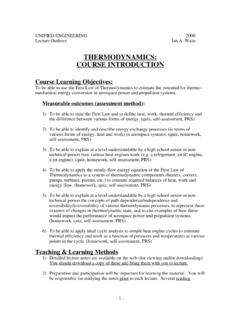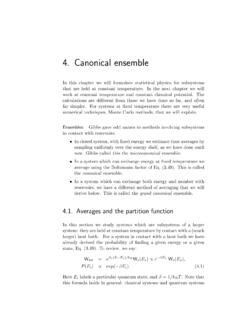Transcription of Turbo Machines (18ME54) Keerthi Kumar N.
1 Turbo Machines (18ME54) Keerthi Kumar N. Department of Mechanical Engineering, BMSIT&M, Bangalore Page 1 BMS Institute of Technology and Management Department of Mechanical Engineering NOTES of Turbo Machines 18ME54 Turbo Machines (18ME54) Keerthi Kumar N. Department of Mechanical Engineering, BMSIT&M, Bangalore Page 2 Table of Content Chapter No Chapter Name Page No 1 Introduction to Turbo Machines .
2 3 2 thermodynamics of Fluid Flow. 21 3 Energy Exchange in Turbo Machines 46 4 Steam Turbine. 80 5 Hydraulic Turbines. 97 6 Centrifugal Pumps. 112 7 Centrifugal Compressors. 126 Turbo Machines (18ME54) Keerthi Kumar N. Department of Mechanical Engineering, BMSIT&M, Bangalore Page 3 Chapter 1 INTRODUCTION TO TURBOMACHINES Introduction: The turbomachine is used in several applications, the primary ones being electrical power generation, aircraft propulsion and vehicular propulsion for civilian and military use.
3 The units used in power generation are steam, gas and hydraulic turbines, ranging in capacity from a few kilowatts to several hundred and even thousands of megawatts, depending on the application. Here, the turbomachines drives the alternator at the appropriate speed to produce power of the right frequency. In aircraft and heavy vehicular propulsion for military use, the primary driving element has been the gas turbine. Turbomachines and its Principal Components: Question No : Define a turbomachine. With a neat sketch explain the parts of a turbomachine. (VTU, Dec-06/Jan-07, Dec-12, Dec-13/Jan-14) Answer: A turbomachine is a device in which energy transfer takes place between a flowing fluid and a rotating element due to the dynamic action, and results in the change of pressure and momentum of the fluid.
4 Fig. Principal components of turbomachine The following are the principal components of turbomachine: (i) Rotor, (ii) Stator and (iii) Shaft. Rotor is a rotating element carrying the rotor blades or vanes. Rotor is also known by the names runner, impellers etc. depending upon the particular machine. Here energy transfer occurs between the flowing fluid and the rotating element due to the momentum exchange between the two. Turbo Machines (18ME54) Keerthi Kumar N. Department of Mechanical Engineering, BMSIT&M, Bangalore Page 4 Stator is a stationary element carrying the guide vanes or stator blades.
5 Stator blades are also known by guide blades or nozzle depending upon the particular machine. These blades usually control the direction of fluid flow during the energy conversion process. Shaft is transmitting power into or out of the machine depending upon the particular machine. For power generating Machines , it may call as output shaft and for power absorbing Machines ; it may called as input shaft. Classification of Turbomachines: Question No : Explain how turbomachines are classified. Give at least one example of each. (VTU, Feb-06, Jun/Jul 14) Answer: Turbomachines are broadly classified into power generating, power absorbing and power transmitting turbomachines.
6 In power-generating turbomachines, fluid energy (decrease in enthalpy) is converted into mechanical energy which is obtained at the shaft output, whereas in power-absorbing turbomachines, mechanical energy which is supplied at the shaft input is converted to fluid energy (increase in enthalpy). The power-transmitting turbomachines are simply transmitting power from input shaft to an output shaft. That means, these devices act merely as an energy transmitter to change the speed and torque on the driven member as compared with the driver. Again power-generating and power-absorbing turbomachines are classified by the direction of the fluid flow as: (i) axial flow, (ii) radial flow and (iii) mixed flow.
7 In the axial flow and radial flow turbomachines, the major flow directions are approximately axial and radial respectively, while in the mixed flow machine, the flow enters axially and leaves radially or vice versa. A radial flow machine may also be classified into radial inward flow (centripetal) or radial outward flow (centrifugal) types depending on whether the flow is directed towards or away from the shaft axis. Question No : Explain with examples the power generating, power absorbing and power transmitting turbomachines. (VTU, Jul/Aug-02, Jun/Jul-13) Answer: Power generating turbomachine is one which converts fluid energy in the form of kinetic energy or pressure energy into mechanical energy in terms of rotating shaft.
8 Turbines are the best example for this type. Power absorbing turbomachine is one which converts mechanical energy into fluid energy. Compressors, fans, pumps and blowers are the best example for this type. Power transmitting is one which is used to transmit power from driving shaft to driven shaft with the help of fluid. There is no mechanical connection between the two shafts. The best examples for this type are hydraulic coupling and hydraulic torque converter. Turbo Machines (18ME54) Keerthi Kumar N.
9 Department of Mechanical Engineering, BMSIT&M, Bangalore Page 5 Question No : What is an axial flow turbomachine? How is it different from a radial flow turbomachine? Give one example each. Answer: In axial flow turbomachine, the major flow direction is approximately axial, example: Kaplan turbine. Whereas in radial flow turbomachine, the major flow direction is radial, example: Francis turbine. Positive-Displacement Devices and Turbomachines: Question No : Compare the turbomachines with positive displacement Machines . (VTU, Jan/Feb-02, Jan/Feb-03, Jan/Feb-04, Dec-12, Jun/Jul-13) Answer: The differences between positive-displacement Machines and turbomachines are given by comparing their modes of action, operation, energy transfer, mechanical features etc.
10 In the following table. Modes Positive-displacement Machine Turbomachine Action (a) It creates thermodynamic and mechanical action between a nearly static fluid and a relatively slowly moving surface. (a) It creates thermodynamic and dynamic interaction between a flowing fluid and rotating element. (b) It involves a change in volume or a displacement of fluid. (b) It involves change in pressure and momentum of the fluid. (c) There is a positive confinement of the fluid in the system. (c) There is no positive confinement of the fluid at any point in the system. Operation (a) It involves a reciprocating motion of the mechanical element and unsteady flow of the fluid.





